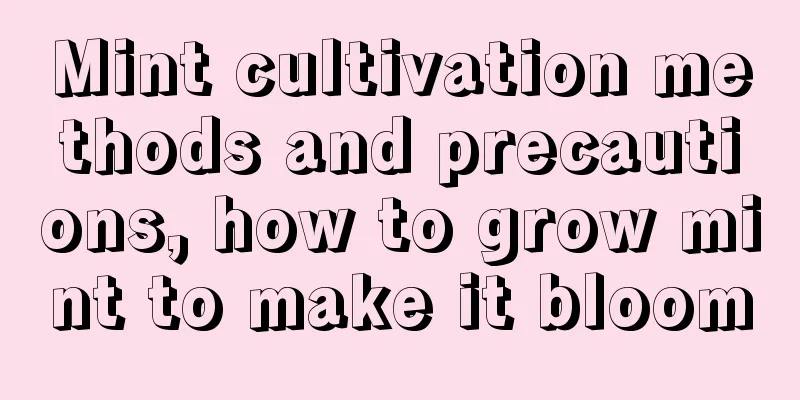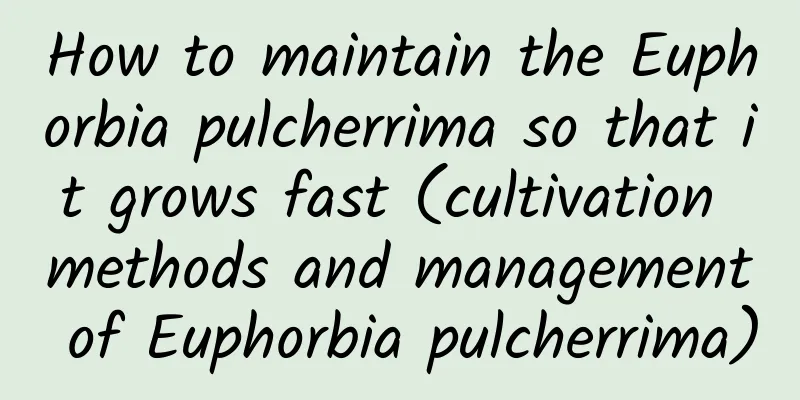Mint cultivation methods and precautions, how to grow mint to make it bloom

1. Adequate sunlightMint is a long-day crop. If there is insufficient light, it will not only affect its development, but also reduce the content of menthol and peppermint oil. Generally, it should be placed in a sunny place and the light time should be as long as possible every day. This is conducive to the differentiation of flower buds and better photosynthesis. It should be noted that the seedlings should be avoided from strong sunlight, otherwise they will be burned. It will be fine when they grow a little bigger. 2. Suitable soilMint does not have very high requirements for soil. Generally, as long as the soil is not severely desertified or too sticky, it will be fine. At the same time, it is also necessary to avoid using a substrate with too strong acidity or alkalinity to plant it. You can mix garden soil, humus soil and sandy soil. The sand content should not be too high so as not to affect the growth of the roots. The soil must be thoroughly disinfected before use. It can be exposed to the sun or stir-fried in a waste pot. 3. Water appropriatelyIn order to promote the growth of mint, sufficient water should be provided in the early and middle stages. Generally, it needs to be watered once every 15 days, so that it can grow quickly. When it grows to a certain size, the amount of water should be properly controlled. By controlling the water, you can prevent it from growing too fast and reduce the possibility of lodging. Generally, you only need to water the seeds 4-5 times after germination before harvesting, and stop watering 25 days before harvesting. 4. Pay attention to fertilizationWhen planting mint, you need to apply enough base fertilizer. Base fertilizer generally consists of decomposed compost, superphosphate and bone meal, which can ensure comprehensive nutrition and is not easy to cause fertilizer damage. When the seedlings grow to 10-15 cm in height, they need appropriate topdressing. At this time, urea is mostly used as fertilizer to promote the development of branches and leaves. Fertilizer needs to be fully diluted before application to avoid damage to the roots caused by concentrated fertilizer. |
<<: Is it normal for orchid leaves to curl after being potted? How to deal with it after potting
>>: The correct way to water mint, precautions for watering mint
Recommend
How to grow water lily
1. Maintenance methods 1. Temperature: Whether th...
Causes and treatments for yellowing daffodil leaves
1. Unreasonable temperature and light 1. Reason: ...
How to grow chrysanthemums in winter
1. South Because the temperature in the south is ...
The Kalanchoe plant grows rapidly, but only grows leaves but no flowers? Come for 1 dollar and I’ll sell you a large quantity in 1 month!
What should I do if the Kalanchoe grows too tall?...
Is pumpkin a squash? What is the difference between squash and pumpkin?
1. The difference between pumpkin and squash Acco...
How to plant grape seeds
Grape Seed Introduction Grape seeds are easy to o...
How to make the green radish grow quickly
1. Suitable lighting The green radish has strong ...
When is the best time to plant daffodils? How many months do you need to wait for daffodil bulbs to bloom during the Spring Festival?
When to plant daffodils The best time to plant da...
Can Nandina domestica be planted at the doorstep?
Can Nandina domestica be planted at the doorstep?...
Cultivation methods and precautions of bicolor jasmine
1. Maintenance methods 1. Temperature: Between 18...
What is the best way to grow prune seedlings?
Prune is an introduced variety of plum. It is kno...
How to propagate dahlias by cuttings
Dahlia cutting time The time for cuttings can be ...
Which places in China are suitable for growing cherries (the places with the most cherry planting in China)
Which places in my country are suitable for growi...
Old succulent plants are too expensive! In just 4 steps, the seedling can be turned into an old tree immediately, without spending a penny!
Change to a larger pot to give the succulents eno...
What are the colorful leaf plants?
1. Spring Red It is a seasonal colorful leaf plan...









